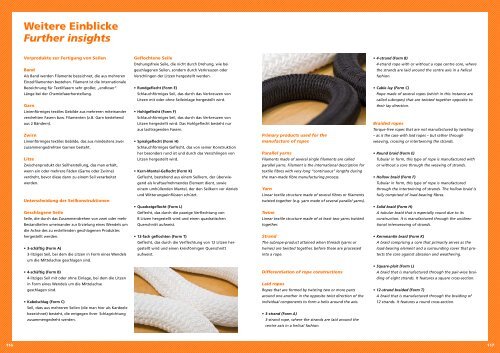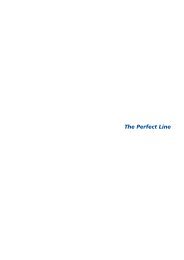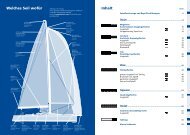GeoMarine - Gleistein
GeoMarine - Gleistein
GeoMarine - Gleistein
Erfolgreiche ePaper selbst erstellen
Machen Sie aus Ihren PDF Publikationen ein blätterbares Flipbook mit unserer einzigartigen Google optimierten e-Paper Software.
Weitere Einblicke<br />
Further insights<br />
Vorprodukte zur Fertigung von Seilen<br />
Band<br />
Als Band werden Filamente bezeichnet, die aus mehreren<br />
Einzelfilamenten bestehen. Filament ist die internationale<br />
Bezeichnung für Textilfasern sehr großer, „endloser“<br />
Länge bei der Chemiefaserherstellung.<br />
Garn<br />
Linienförmiges textiles Gebilde aus mehreren miteinander<br />
verdrehten Fasern bzw. Filamenten (z.B. Garn bestehend<br />
aus 2 Bändern).<br />
Zwirn<br />
Linienförmiges textiles Gebilde, das aus mindestens zwei<br />
zusammengedrehten Garnen besteht.<br />
Litze<br />
Zwischenprodukt der Seilherstellung, das man erhält,<br />
wenn ein oder mehrere Fäden (Garne oder Zwirne)<br />
verdreht, bevor diese dann zu einem Seil verarbeitet<br />
werden.<br />
Unterscheidung der Seilkonstruktionen<br />
Geschlagene Seile<br />
Seile, die durch das Zusammendrehen von zwei oder mehr<br />
Bestandteilen umeinander zur Erzielung eines Wendels um<br />
die Achse des zu erstellenden geschlagenen Produktes<br />
hergestellt werden.<br />
• 3-schäftig (Form A)<br />
3litziges Seil, bei dem die Litzen in Form eines Wendels<br />
um die Mittelachse geschlagen sind.<br />
• 4-schäftig (Form B)<br />
4litziges Seil mit oder ohne Einlage, bei dem die Litzen<br />
in Form eines Wendels um die Mittelachse<br />
geschlagen sind.<br />
• Kabelschlag (Form C)<br />
Seil, dass aus mehreren Seilen (die man hier als Kardeele<br />
bezeichnet) besteht, die entgegen ihrer Schlagrichtung<br />
zusammengedreht werden.<br />
Geflochtene Seile<br />
Drehungsfreie Seile, die nicht durch Drehung, wie bei<br />
geschlagenen Seilen, sondern durch Verkreuzen oder<br />
Verschlingen der Litzen hergestellt werden.<br />
• Rundgeflecht (Form E)<br />
Schlauchförmiges Seil, das durch das Verkreuzen von<br />
Litzen mit oder ohne Seileinlage hergestellt wird.<br />
• Hohlgeflecht (Form F)<br />
Schlauchförmiges Seil, das durch das Verkreuzen von<br />
Litzen hergestellt wird. Das Hohlgeflecht besteht nur<br />
aus lasttragenden Fasern.<br />
• Spiralgeflecht (Form H)<br />
Schlauchförmiges Geflecht, das von seiner Konstruktion<br />
her besonders rund ist und durch das Verschlingen von<br />
Litzen hergestellt wird.<br />
• Kern-Mantel-Geflecht (Form K)<br />
Geflecht, bestehend aus einem Seilkern, der überwiegend<br />
als kraftaufnehmendes Element dient, sowie<br />
einem umhüllenden Mantel, der den Seilkern vor Abrieb<br />
und Witterungseinflüssen schützt.<br />
• Quadratgeflecht (Form L)<br />
Geflecht, das durch die paarige Verflechtung von<br />
8 Litzen hergestellt wird und einen quadratischen<br />
Querschnitt aufweist.<br />
• 12-fach geflochten (Form T)<br />
Geflecht, das durch die Verflechtung von 12 Litzen hergestellt<br />
wird und einen kreisförmigen Querschnitt<br />
aufweist.<br />
Primary products used for the<br />
manufacture of ropes<br />
Parallel yarns<br />
Filaments made of several single filaments are called<br />
parallel yarns. Filament is the international description for<br />
textile fibres with very long “continuous” lengths during<br />
the man-made fibre manufacturing process.<br />
Yarn<br />
Linear textile structure made of several fibres or filaments<br />
twisted together (e.g. yarn made of several parallel yarns).<br />
Twine<br />
Linear textile structure made of at least two yarns twisted<br />
together.<br />
Strand<br />
The subrope-product attained when threads (yarns or<br />
twines) are twisted together, before these are processed<br />
into a rope.<br />
Differentiation of rope constructions<br />
Laid ropes<br />
Ropes that are formed by twisting two or more parts<br />
around one another in the opposite twist direction of the<br />
individual components to form a helix around the axis.<br />
• 3-strand (Form A)<br />
3-strand rope, where the strands are laid around the<br />
centre axis in a helical fashion.<br />
• 4-strand (Form B)<br />
4-strand rope with or without a rope centre core, where<br />
the strands are laid around the centre axis in a helical<br />
fashion.<br />
• Cable lay (Form C)<br />
Rope made of several ropes (which in this instance are<br />
called subropes) that are twisted together opposite to<br />
their lay direction.<br />
Braided ropes<br />
Torque-free ropes that are not manufactured by twisting<br />
– as is the case with laid ropes – but rather through<br />
weaving, crossing or intertwining the strands.<br />
• Round braid (Form E)<br />
Tubular in form, this type of rope is manufactured with<br />
or without a core through the weaving of strands.<br />
• Hollow braid (Form F)<br />
Tubular in form, this type of rope is manufactured<br />
through the intertwining of strands. The hollow braid is<br />
fully comprised of load-bearing fibres.<br />
• Solid braid (Form H)<br />
A tubular braid that is especially round due to its<br />
construction. It is manufactured through the unidirectional<br />
interweaving of strands.<br />
• Kernmantle braid (Form K)<br />
A braid comprising a core that primarily serves as the<br />
load-bearing element and a surrounding cover that protects<br />
the core against abrasion and weathering.<br />
• Square-plait (Form L)<br />
A braid that is manufactured through the pair-wise braiding<br />
of eight strands. It features a square cross-section.<br />
• 12-strand braided (Form T)<br />
A braid that is manufactured through the braiding of<br />
12 strands. It features a round cross-section.<br />
116 117





